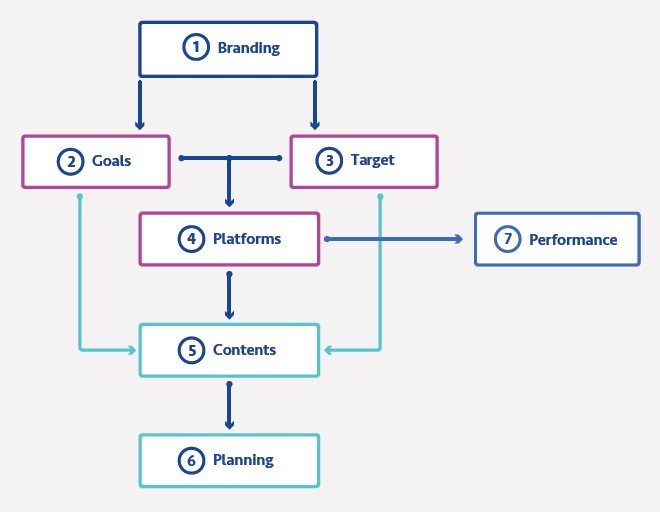Social media strategy
Social media platforms have changed the way we communicate today. For research infrastructures, these platforms can be a great way to reach out to potential users and engage them in different activities.
To improve and create common standards for European Research Infrastructures, we present (1) a model to create a social media strategy adapted to their needs and constraints and a (2) list of common hashtags that all research infrastructures could use collectively to boost their online visibility.
Your social media strategy should be perfectly aligned with (and integrated into) the overall communication strategy of your research infrastructure. This 7-phase model will help you develop your social media strategy and challenge you to elevate the quality and balance of your posts.

First you need to define your branding, by specifying how you want to position your research infrastructure, what are your main key messages, what is your “pitch”.
Then you need to set the basis: the goals you aim to achieve and the targets you aim to engage using social media platforms.
Once you define this, you will be prepared to choose the most appropriate social media platforms for your research infrastructure.
Considering all the previous phases, you can move on to defining your content strategy and planning.
Finally, you should measure your performance, which will help you to improve and adjust the previous phases and achieve an effective communication.
Guidelines for branding
Spell out the name of your research infrastructure
Include your logo and a descriptive image of your research field
Convey your key messages using an “elevator pitch” approach, that is, explaining what makes you unique in a (very) short compelling story
Do mention that you are a research infrastructure (do not use the RI acronym, though)
Goals: What do you want to achieve through social media?
Your goals should determine your strategy. Clearly define specific and measurable goals that you may achieve through social media.
Frequent goals of research infrastructures
(highly recommended):
- Increase the visibility of your research infrastructure
- Promote your events, services, job opportunities and calls
- Generate traffic to your website
- Promote your services and projects
- Increase your networking: partners and prospective users
- Increase user engagement (establish dialogue)
- Promote the results and outputs of the access to facilities, services or resources that you provide
(also recommended):
- Promote events, job opportunities and calls from your partners (e.g.: other research infrastructures, partners in projects and clusters)
- Promote your own nodes/hubs
- Increase the visibility of your nodes/hubs
- Create outreach campaigns
- Promote your funding institutions
Target audience: Who do you want to reach?
Suggestions: Common targets include people and entities from:
- Research (from fields directly related to your research infrastructure and from other fields / from academia or from the private sector)
- Private sector – business and industry
- Other European Research Infrastructures
- Research infrastructures counterparts outside of Europe
- Decision-makers
- Funding institutions
- Pan-European clusters, projects and initiatives
- Younger generations
- General public
- Internal research infrastructure community
- Demographic group
- Affinities (interests, preferences, etc)
- Economic sector or occupation
- Nationality (e.g.: from your member countries, other EU countries or countries outside the EU zone)
RI-VIS has created guidelines for targeting three specific user groups: 1) Research Infrastructures outside of Europe, 2) the private sector and 3) decision-makers. See their guidelines and best practices here.
Social media platforms: Which ones should you use?
Identify the social media platforms that are most appropriate to reach your different target audiences and achieve your defined goals, considering:
- Who are the users of each platform, and what do they use this platform for?
- How many people use specific social media platforms (penetration rate) in each country/region you want to reach?
- What is your own capacity to allocate to social media (resources, contents, etc)?
Creating content for social media
Step 1:
Identify the social media platforms that are most appropriate to reach your different target audiences and achieve your defined goals, considering:
- Who are the users of each platform, and what do they use this platform for?
- How many people use specific social media platforms (penetration rate) in each country/region you want to reach?
- What is your own capacity to allocate to social media (resources, contents, etc)?
CREATING CONTENT FOR SOCIAL MEDIA
Step 1:
Define the type of content that is most suitable to achieve the goals you have set for your target audiences.
Step 2:
Find creative and appealing ways to produce the content.
